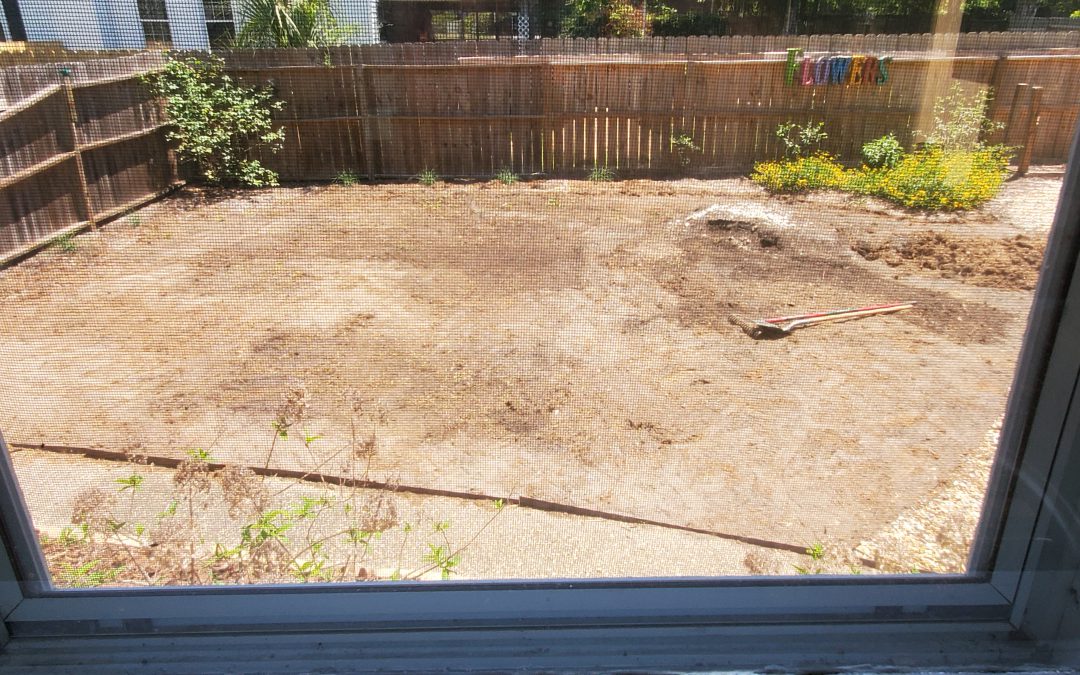
by Stephen Greer | Aug 10, 2023
It is mid-summer with temperatures outside in the 90’s plus, so you may wonder why article on landscape installation considerations during this time of year. It simply is an excellent time for planning and preparing for fall and winter site prep and planting well before it arrives, reducing a time crunch when it is time to plant.
Think healthy plants for our Northwest Florida settings, proper preparation of the site before planting, and many other points to be successful with establishing a landscape that will be enjoyed by all. This article will address the use of woody ornamental plants, but many things discussed can be applied to perennials and annuals as well.
Before starting, make sure to do your homework not only on the plants and placement in the landscape, but any county, city, or homeowner association requirements to work within. Many neighborhoods have review committees for these approvals. This commitment by you when purchasing property and a home can be a part of the closing papers during the purchase. If you are required to submit for an approval before work can begin you might want to consider consulting with a professional landscape company to assist in this process. Always ask for references and sites you can visit before securing services.
Site preparation can be a afterthought, with limited funding focused on this critical area, but properly addressing it leads to healthy, vigorous plant establishment and future growth. Understanding the site from soil type and drainage, size of area, sunlight, water availability, plus needs of prospective plants goes a long way to being successful. If there are plants already established on site that may be worth keeping, be sure to include them in the consideration. Determining soil drainage, moisture retention that would be available to plants, soil pH and structure will also go a long way to determining the type of plants that work best for the site. If, for example, your site does not drain well and holds higher levels of water in the root zone area (top 12″ of soil), consider plants that grow well in wet settings. The next steps are determining soil pH and nutrient needs for general landscape plant growth performance. Many plants thrive in slightly acidic soil (pH 6.0 to 7.0 range) while others grow best in moderately acidic settings (pH 5.0 to 6.0 range). Contact your local UF IFAS Extension office in your county for additional information.
The landscape site brings other considerations for plants to flourish, involving space and light. Space should be considered both above and below ground. With the above ground area, is there room for the limbs to expand in width and height? If pruning is required to manage the size, considering another plant may be a viable option. Next is the root growth and expansion opportunity for the plant. If the root area is limited in space, other options may need to be considered to mitigate compacted soils or pavement areas. Adding raised beds for better soil drainage and increased root growth room may be an option. Be sure to know your soil type and use a similar soil with characteristic that match the existing soil. If you do not, there can be incompatibility that leads to a hard pan layer between the soils reducing potential root zone establishment.
The desire to develop and establish an enjoyable landscape for all to appreciate can be a challenge, but a positive one. As a reminder, call and go visit with your local UF IFAS Extension office, there is great research information available for the asking. Enjoy your gardening experience.
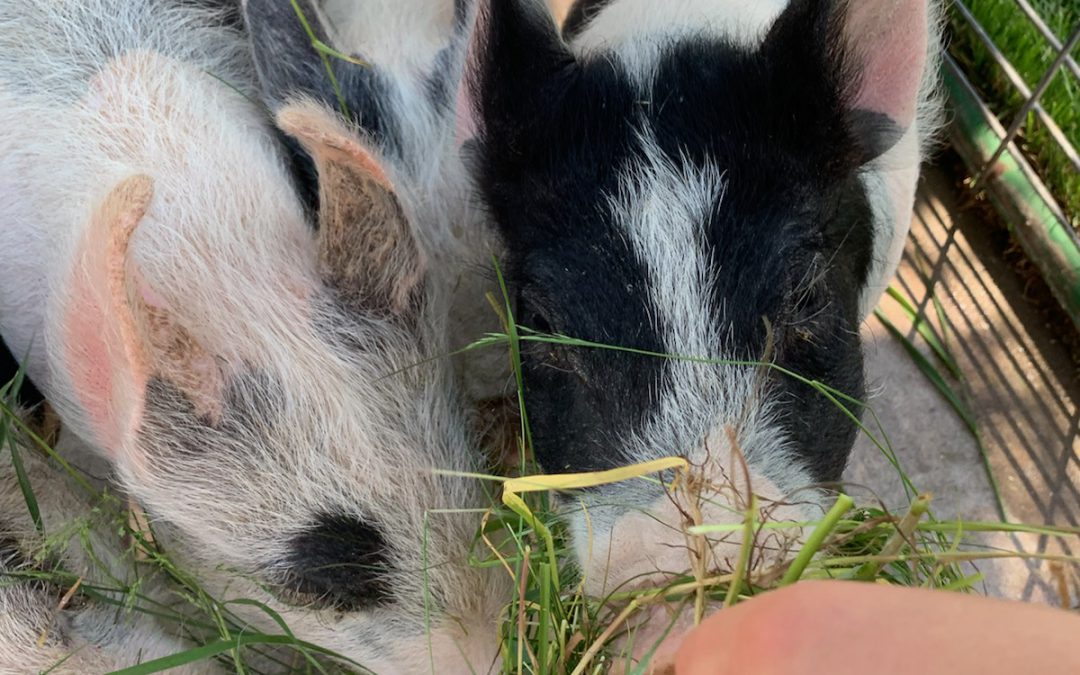
by Molly Jameson | Oct 3, 2022
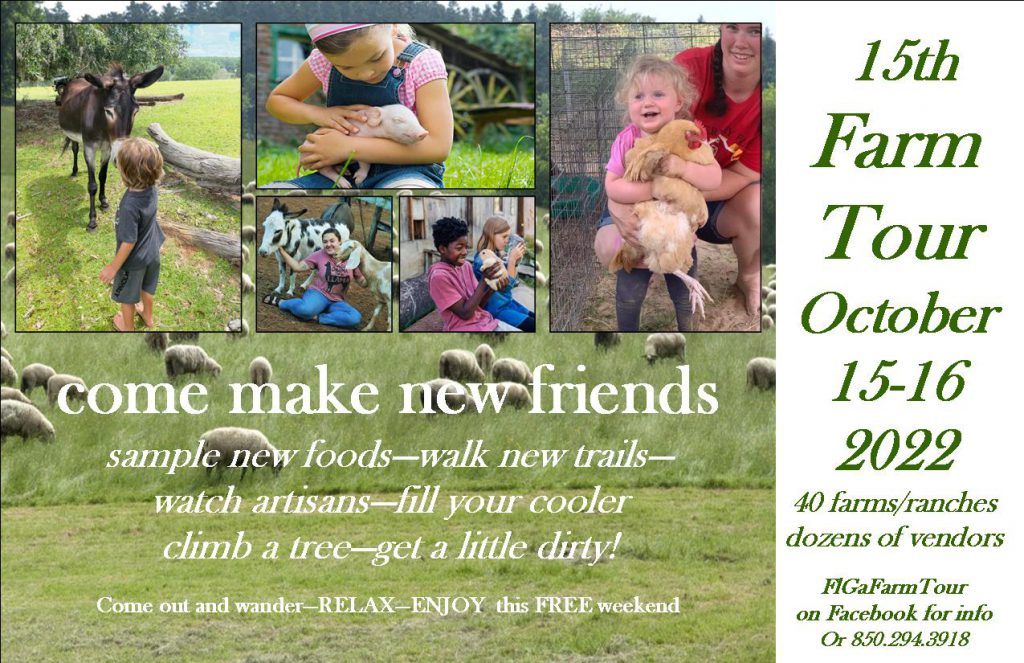
Come on down to the farm! The 15th Annual Farm Tour is October 15 and 16. Image by Millstone Institute of Preservation.
Fall is upon us, and that means it is farm tour season!
The 15th Annual Farm Tour is on Saturday, October 15 and Sunday, October 16, 2022. Farmers and producers in 12 counties in North Central Florida and South-Central Georgia will be open to showcase their various farming endeavors. It is a free family weekend of learning, exploration, and fun.
The Farm Tour has been organized and hosted by Millstone Institute of Preservation since 2016. It gives the community the chance to explore local producers in our area and become familiar with the farmers that make up our diverse local food system.
There are 40 farms, ranches, farm-to-table restaurants, markets, vendors, and gardens (including the Leon County “VegHeadz” Demonstration Garden on Saturday!) participating in this year’s Farm Tour, some of which have never participated in the past.
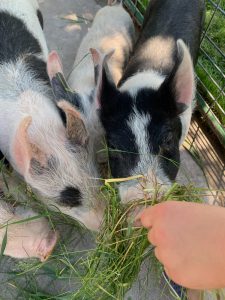
There is much to explore during the 15th Annual Farm Tour, including heritage breed livestock. Photo by Rachel Mathes.
The sites span nearly 140 miles east to west, from Greenville, Florida, to Chipley, Florida, and about 80 miles north to south, from Whigham, Georgia, to Crawfordville, Florida.
Each farm is open to the public at no cost, providing the opportunity for participants to learn the importance of supporting local agriculture and how they can do so.
There are many different types of farms to explore, including seeing a multitude of processes and demonstrations firsthand, such as honey harvesting, cow and goat milking, sawmill operating, bamboo extracting, horse grooming, compost turning, flower arranging, seed saving, wine manufacturing, sausage creating, satsuma juicing, cheese making, kombucha brewing, and much more.
You can also sample and purchase local products at many farm tour sites, including local honey, beeswax and honey products, local eggs, homemade breads, fresh veggies, various locally produced meats (bring a cooler!), pumpkins, vegetable seedlings, kombucha, muscadine wines, handmade soaps, fruit trees, cookbooks, and more. Many locations will also be serving food for sale, such as falafel and hummus; baked goods; beef, bacon, and pork burgers; ice cream and coffee; satsuma slushes, cookies, jellies, and syrups; and much more.
The Farm Tour Guide includes descriptions and directions to all the farm tour sites. A downloadable version of the Farm Tour Guide is available on the UF/IFAS Leon County Extension Facebook or you can download a copy using this link: https://drive.google.com/file/d/1kJIEUcHh1w55BS9y1fpUjfV5yb-MDMJa/view?fbclid=IwAR2Pt0jdjMmZrc9UaJ0tYn_eGnMkem8DvfjdPbkzsTaF8q7D2bFcFLgsoCs
See you down on the farm!
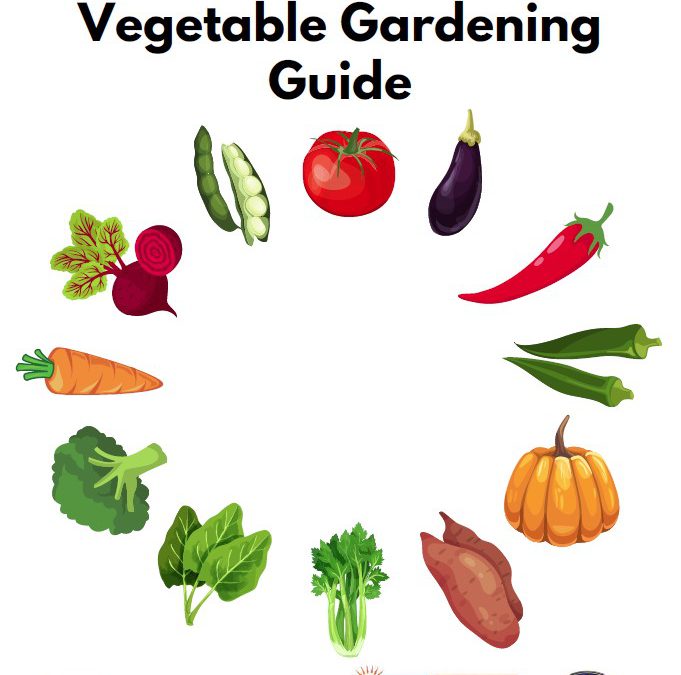
by Molly Jameson | Oct 28, 2021
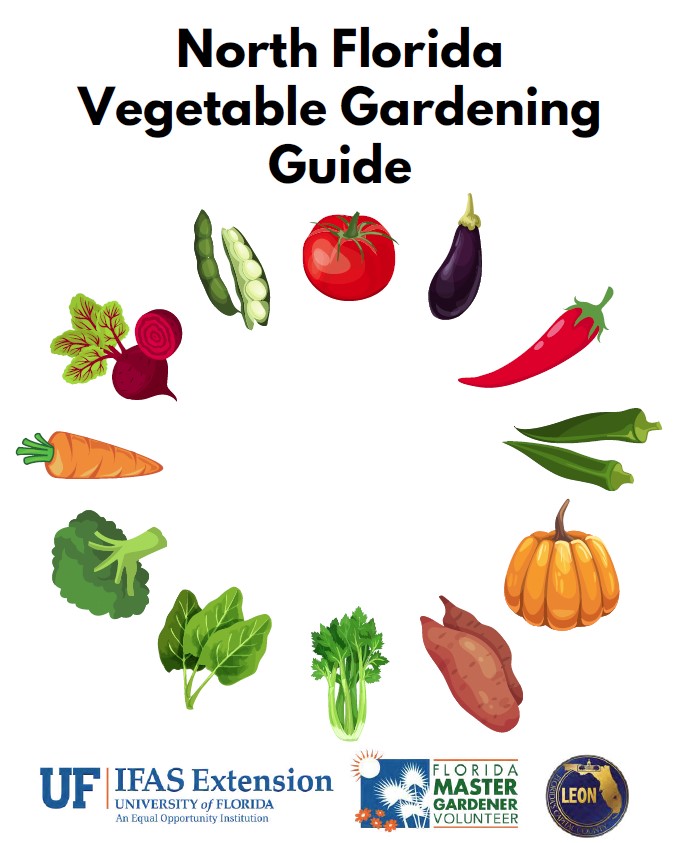
As you garden this fall, check out the North Florida Vegetable Gardening Guide, compiled by UF/IFAS Leon County Extension.
Getting into vegetable gardening, but don’t know where to start?
Even experienced gardeners know there’s always more to learn. To help both beginners and advanced gardeners find answers to their questions, the UF/IFAS Leon County Extension Office put together the North Florida Vegetable Gardening Guide. It incorporates multiple resources, including articles, planting calendars, photos, and UF/IFAS EDIS publications.
The North Florida Vegetable Gardening Guide covers the many aspects of vegetable gardening, including how to get started, site selection, insects and biodiversity in the garden, soil testing, composting, cover crops in the garden, irrigation, and more.
You can click here to view the digital version of the guidebook. We also have physical copies of the guide available at the UF/IFAS Leon County Extension Office (615 Paul Russell Rd., Tallahassee, FL 32301).
Happy fall gardening!
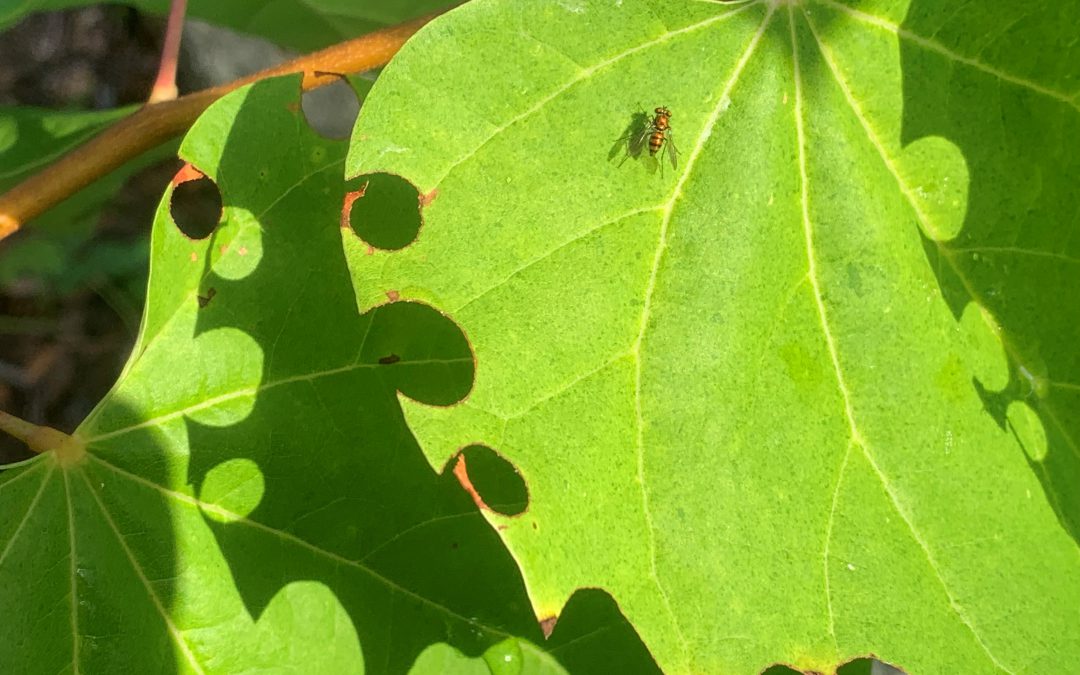
by Beth Bolles | Aug 18, 2021
In a garden with a variety of flowers, pollinators will be abundant. Sometimes we don’t always recognize the specific pollinator when we see it, but there are some native pollinators that leave other signs of their activity. One of our medium-sized native bees will leave a distinctive calling card of recent activity in our landscape.
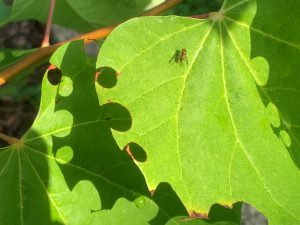
Leafcutter bees have collected circular notches from the edges of a redbud tree. Photo by Beth Bolles, UF IFAS Extension Escambia County.
If you see some of the leaves of trees and shrubs with distinct circular notches on the edges of the leaves, you can be sure the Leafcutter bee is present. The females collect the leaf pieces to make a small, cigar-shaped nest that may be found in natural cavities, such as rooting wood, soil, or in plant stems. Each nest will have several sections in which the female places a ball of pollen and an egg. The emerging larvae then have a plentiful food source in order to develop into an adult bee.
When identifying a leafcutter bee in your landscape, look for a more robust bee with dark and light stripes on the abdomen. These bees also have a hairy underside to their abdomen where they carry the pollen. When loaded with pollen their underside will look yellow.
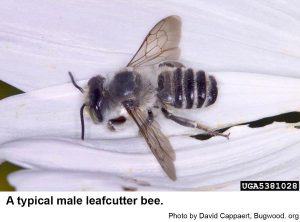 Leafcutter bees are solitary bees that are not considered aggressive. A sting would only be likely if the bee is handled. Your landscape will have many plants that a leafcutter may use for nesting material. The pollinating benefits of these bees far outweigh any cosmetic injury to the plant leaf margins.
Leafcutter bees are solitary bees that are not considered aggressive. A sting would only be likely if the bee is handled. Your landscape will have many plants that a leafcutter may use for nesting material. The pollinating benefits of these bees far outweigh any cosmetic injury to the plant leaf margins.
Visit Featured Creatures to see a photo of the leaf pieces made into a nest.









